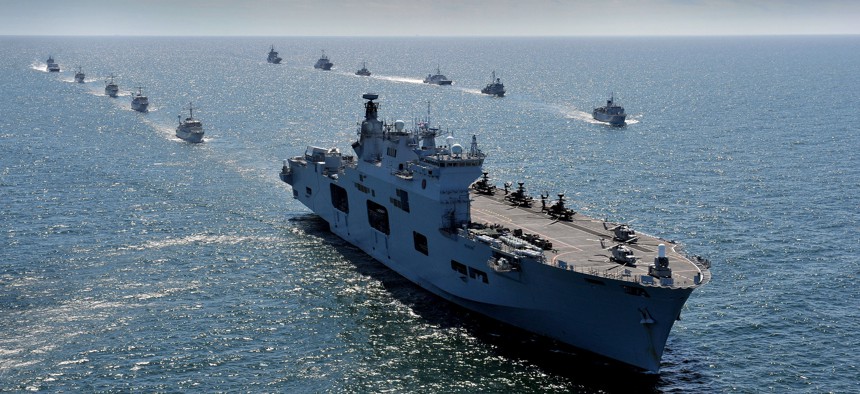
LPhot Luron Wright/Crown Copyright via U.S. Navy
At BALTOPS, It’s Back to Prepping for High-End Warfare
The annual NATO exercise in tight Baltic waters, grown a bit sleepy after the Cold War, has snapped back into serious intensity.
ABOARD THE ROALD AMUNDSEN – The small boat with the big twin outboard motors zipping across the nearly calm blue-green waters has the crew of the Royal Norwegian Navy's frigate Roald Amundsen worried. Neither radio calls nor warning shots from a machine gun deter the fast-approaching boat, and so the frigate’s CO makes his decision. The deck crew, all wearing tactical gear and helmets, find some cover on the bridge wing and open up with their assault rifles. The steady thuds from the Amundsen’s .50-caliber machine gun soon join the fracas. The fast boat weaves and dodges as the frigate’s crew pours rifle and machine gun fire on it — all blanks, of course.
This is not part of a counter-piracy mission off the coast of Somalia, or a maritime counter-terrorism drill in the Arabian Gulf. This is BALTOPS, the largest annual naval exercise in the Baltic Sea, a region made tense by a Russia seemingly bent on reordering European security and challenging American leadership on the continent.
The BALTOPS exercise has been around for decades, but a sleepiness had descended upon it after the end of the Cold War. The focus of the exercise evolved towards softer maritime security tasks, such as counter-terrorism, maritime escort, and interdicting illicit shipments. Even Russia's Baltic Sea Fleet became a regular participant back when the world was thought to have moved beyond geopolitical competition, and peace and stability at sea was primarily threatened by pirates, smugglers, and terrorist groups. This all changed in 2014, when Russia annexed Crimea and touched off conflict in eastern Ukraine. The Baltic Sea region became a primary friction zone between NATO and Russia, which has since poured billions into military modernization, held a string of snap exercises close to the Western alliance’s most exposed members, and stepped up naval and air activities in the region.
This has brought the BALTOPS exercise back to preparing Alliance navies for high-end maritime warfighting. And while fighting off small boats is still part of the exercise, the fifty ships, roughly fifty aircraft, and 4,000 personnel from twelve NATO nations, are really in the Baltic to sharpen their skills in anti-submarine warfare, air defense, amphibious landings, mine hunting, and the integration of air and maritime power.
The Baltic presents special challenges for naval forces. Its shallow, brackish waters play havoc with anti-submarine sensors designed for deeper seas. The radar picture is cluttered with commercial traffic and windfarms. This is especially true in the southern Baltic Sea, where BALTOPS 2017 is running from June 1-16, and where merchantmen funnel toward the Kiel Canal and the Danish Straits en route to the North Sea and to the broader North Atlantic. As I hop between warships on a U.S. Navy SH-60 helicopter, large merchant ships are nearly always in view from my perch. And in the Baltic Sea, one is never very far from land, which means that warships and aircraft are nearly always exposed to shore-based missile batteries. This is no theoretical threat: in its southeastern Baltic enclave of Kaliningrad, Russia has assembled a veritable bastion of anti-ship, air defense, and ballistic missile systems.
These challenges are not lost on the BALTOPS navies. The exercise is led by Vice Adm. Christopher Grady, commander of the U.S. Navy's Sixth Fleet in Europe, who in interviews repeatedly returns to how "brutal the fight at sea would be in the Baltic." Grady took up his Sixth Fleet duties late last year, but this is not his first time working with European navies. In 2004, he commanded the USS Cole when it was part of NATO's Standing Naval Force in the Mediterranean, back when the Alliance faced a very different maritime security environment. But out at BALTOPS, Grady, who makes it hard to miss that he is a rabid Notre Dame football fan, worries about more than just the pointy end of the spear. To win at high-end warfighting at sea, he also wants the U.S. and its European allies to get better at more mundane tasks, such as casualty care, logistics, and underway replenishment.
The transatlantic relationship is currently fraught, with President Trump hectoring NATO's European members to spend more on defense, while at the same time refusing to clearly state America's commitment to European security (although other members of the Trump administration have done exactly that). European allies, meanwhile, have begun to think out loud about a path away from relying on the United States for protection, while also expressing dismay about other parts of the Trump administration’s agenda. But little of this political friction is visible out in the Baltic Sea. American sailors work shoulder to shoulder with European counterparts on various staffs. U.S. ships take on fuel from a German support ship in the maritime highwire act of underway replenishment. U.S. Marines on the beach call in airstrikes from Polish F-16s.
All these efforts are made easier by longstanding cooperation that has bred deep familiarity, trust, and interoperability among the allies under the NATO umbrella. Grady also emphasizes that in the Baltic Sea, it is not about the U.S. Navy doing anyone any favors; it is very much a valuable learning experience for all participants. In a way, operations here showcase a unique form of burden-sharing: the regional allies bring unrivaled expertise in operating in the cramped and shallow Baltic — it's their backyard, after all — while contributing ships and units tailor-made for the tasks there. America, meanwhile, brings the heavy punch needed in a high-end fight with, among other things, extended air defense, amphibious forces, land attack cruise missiles, and the ability to command and control vast operations.
But for all the high interoperability and spirit of NATO's naval forces on display during BALTOPS, the Alliance still faces a mountain of work here and elsewhere. As I talk to the officers and crews of Estonian, German, Danish, Norwegian, Dutch, and American ships, one thing becomes clear: until just a few years ago, their collective minds were focused elsewhere, such as the Mediterranean, the Indian Ocean, or the Horn of Africa, where the bad guys were more likely armed with AK-47s and rocket-propelled grenades, rather than supersonic anti-ship missiles and submarines that nearly rival those of the West. To rebuild those warfighting skills will take time, and more days at sea in exercises such as BALTOPS.
It will also take more ships. Since the end of the Cold War, European navies have certainly become more sophisticated; many of the ships I visited were commissioned in the mid-2000s and feature the latest in sensors, automation, computer-assisted decision-making, and crew comfort, but also faced a steep drop in numbers. But while quality in warships and crews is essential, at some point quantity becomes a quality all its own. The U.S. Navy faces a similar challenge, as it must carefully balance combatant commanders’ demands for fleet presence in Europe, the Middle East, and a Pacific region where China's naval power is growing fast. Several European navies are eyeing an increase in the number of ships and submarines in the coming years, but it will take some time before they arrive in the fleets.
I'm returned ashore by a SH-60 helicopter to the Danish naval base in Korsor. The gray Seahawk turns heads as it clatters in for a landing in this small coastal town which is getting ready for summer and quiet days of vacation, barely aware that just over the horizon, NATO is preparing for a brutal fight at sea.




